Summary of Climate Disasters on the planet from July 17 to July 23, 2024
Anomalous Heat
According to the European Climate Service Copernicus, Monday, July 22, 2024, became
the hottest day on Earth,
breaking the record set the previous day, Sunday.
Records of average global daily temperatures on Earth:
July 6, 2023 — Avg. Temp. +17.08°C (+62.74°F)
July 21, 2024 — Avg. Temp. +17.09°C (+62.76°F)
July 22, 2024 — Avg. Temp. +17.15°C (+62.87°F)
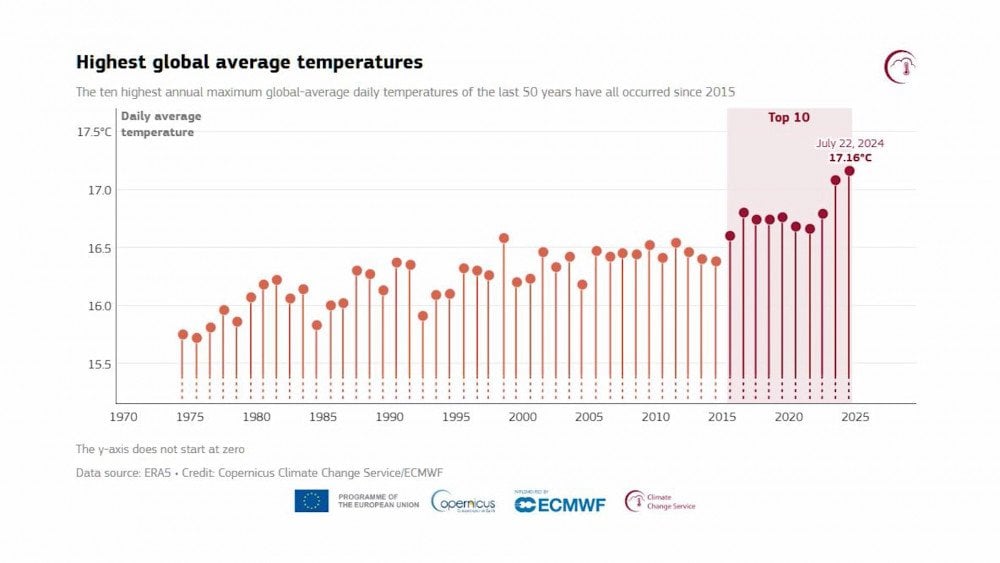
The chart shows the maximum average global temperatures according to the European Climate Service Copernicus
Moreover, June 2024 became the thirteenth hottest consecutive month on the planet since the start of weather tracking.
A record-breaking heatwave has hit East Asia. For several days, the exhausting heat hasn't subsided even at night, providing no relief to people.
In Yueyang County, Hunan Province, China,
the lowest temperature for the day was +32.4°C (+90.3°F).
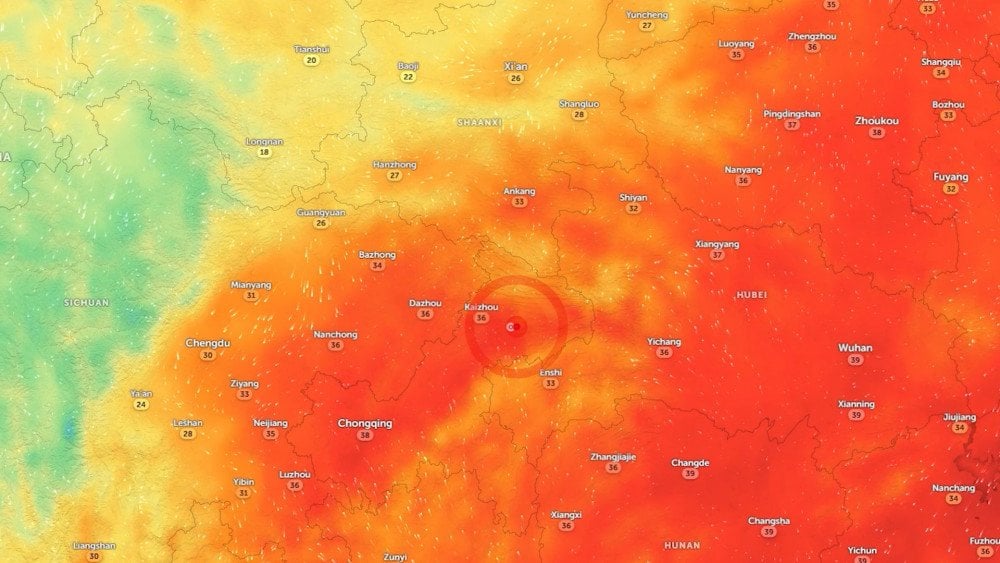
Anomalous heat has settled over a vast area in China
Record low daily temperatures were also recorded in Hangzhou City, Zhejiang Province — +31°C (+87.8°F), and in Jian County, Jiangxi Province — +30.5°C (+86.9°F).
In South Korea, in Gangneung City, Gangwon Province, on July 22, the minimum temperature was +30.2°C (+86.4°F), while the average July minimum is +21°C (+69.8°F).
According to a study by the International Institute for Environment and Development (IIED) in the UK, over the past 10 years in South Korea, the number of days with extreme heat has increased more than sixfold — from 9 to 58 days.
Number of days with anomalous heat in South Korea:
from 1994–2003 — 9 days
from 2004–2013 — 17 days
from 2014–2023 — 58 days
On July 20, the Japanese city of Shizuoka, Shizuoka Prefecture, became the hottest place in the country with a temperature of +38.9°C (+102°F), which is almost 10°C above the norm (Avg. Max Temp. for July — +29°C (+84.2°F)).
In Naha City, Okinawa Prefecture, for the first time in 134 years since record-keeping began in 1890, the temperature reached +36°C (+96.8°F).
And on July 23, the Japan Meteorological Agency and Ministry of the Environment issued
heatstroke risk warnings for 40 of the country’s 47 prefectures.

Temperature records are being set in various prefectures of Japan
Train service was suspended on several sections of the JR Yosan Line On July 21, at Iyo-Ozu Station in Ozu City, Ehime Prefecture, the rail temperature exceeded the set limit of 60°C (+140°F), while rail deformation was recorded in Kagawa Prefecture between Motoyama and Kanonji stations.
Japan
At the same time, other regions of Japan experienced extreme rainfall. On July 20, according to the Japan Meteorological Agency, Tokyo received 50.5 mm (1.99”) of rain in just one hour (the average monthly norm for Tokyo in July is 132.4 mm (5.21”)), while in Otsu, Shiga Prefecture, 90 mm (3.54”) fell, exceeding half of the region's monthly norm for July (the average monthly norm for Otsu in July is 169.9 mm (6.69”)).
On July 20, the Sakurajima volcano erupted explosively on Kyushu Island, Kagoshima Prefecture.

Explosive eruption of Sakurajima volcano on Kyushu Island, Japan
Smoke and ash from the eruption rose to a height of 3.7 km (2.3 miles) above the crater. Large volcanic rock boulders were scattered within a 2 km (1.24 miles) radius.
It is worth noting that Sakurajima is part of the Aira Caldera, one of the most dangerous supervolcanoes on the planet. In recent years, it has been showing increased activity.
South Korea
The capital of South Korea, Seoul, and its suburbs were severely affected by abnormal downpours and floods on July 19.
In some places,
more than 88 mm (3.46”) of rain fell within an hour.
In this region, rainfall over 30 mm (1.18”) per hour is considered heavy, whereas over 50 mm (1.97”) per hour is considered extremely heavy.

Extreme rains hit South Korea
According to the Korean Meteorological Agency (KMA), rainfall intensity in various regions of the country was:
Seoul — more than 50 mm (1.97”)
Pyeongtaek — 88.5 mm (3.48”)
Paju — 69.8 mm (2.75”)
Yeoncheon — 58.5 mm (2.30”)
And in the city of Paju, 634 mm (24.96”) of rain fell in two days, on July 17 and 18. This is almost half of the annual average rainfall (annual average norm is 1,295.8 mm (51”)).
When the water began to rise rapidly, 5 workers were trapped inside a container at a factory. Fortunately, they were discovered and rescued in time.
According to the government, due to the heavy downpours, 901 people were evacuated in 8 provinces.
In Seoul, both directions of the Dongbu Expressway, connecting the city with Gyeonggi Province, were completely stopped due to heavy rain, while sections of the Nambu Ring Expressway were also closed.
At Incheon International Airport, 25 flights were canceled, and 4 airplanes had to return after takeoff due to the bad weather.
China
On the morning of July 17, a massive landslide occurred in Zigui County, Yichang Prefecture, Hubei Province.
According to experts, the volume of the collapsed land is about 800,000 m³ (28,251,500 cubic feet). This is almost equivalent to the volume of one of the most famous skyscrapers in the world — the 102-story Empire State Building in New York. The approximate volume of the building is estimated at 1 million m³ (35,314,700 cubic feet).
The collapse began at the edge of the mountain, but soon most of the mountain slid down.
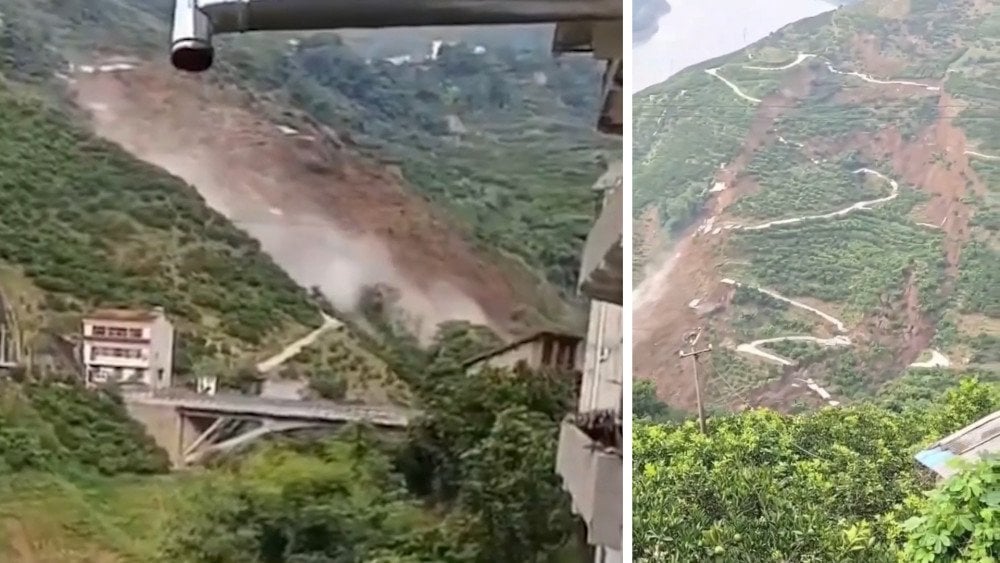
A massive landslide sweeps everything in its path, Hubei Province, China
Along with it, a 1,200-meter (3,937 feet) section of Wugao Road highway, and about 4 hectares (9.88 acres) of citrus orchards slid down.
In Yunnan Province, a landslide blocked a car on the edge of a cliff on the highway.
People had only seconds to escape through the windows and sunroof before the sliding earth pushed the car into the abyss.

Moments before the landslide pushes a car into an abyss, Yunnan Province, China
On July 20, rockfalls blocked roads to 13 villages in Shanglin County, Nanning Prefecture, Guangxi Province. Fortunately, there were no casualties.
Extreme rains and floods have engulfed vast areas of the country.
The water level in the reservoir of the world's largest hydroelectric power station, the Three Gorges Dam on the Yangtze River, Hubei Province, rose 15 meters (49.21 feet) above normal and reached 161.1 meters (528.28 feet).
As of July 17, in Henan Province, the water level in 33 reservoirs exceeded the critical mark.
In order to prevent dam failures, water from reservoirs had to be urgently discharged.
The water rushed downstream, causing sudden devastating floods. Some residents of Henan and Shaanxi provinces had no time to evacuate because the warning about the water discharge came too late.

People move waist-deep and chest-deep in water during severe flooding, China
Some houses, cars, and farmland were flooded or completely destroyed. Rescuers moved through the streets in speedboats to rescue people from flooded homes.
On the eve of July 16, in Dafengying Village, Nanyang City, Henan Province,
606.7 mm (23.88”) of rain fell in one day which is 75% of the annual rainfall norm
(annual average norm is 800 mm (31.50”)),
worsening the situation.
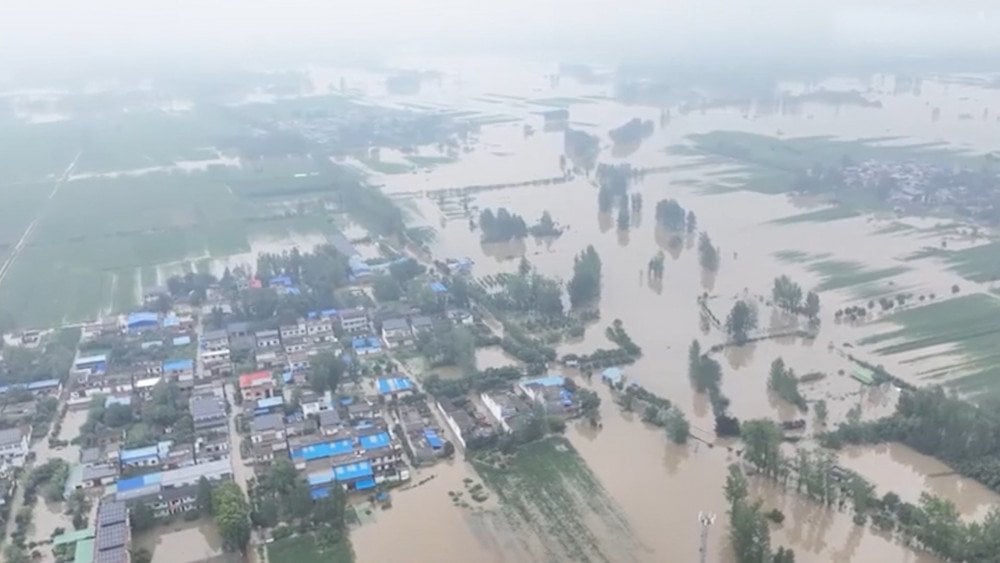
Massive flooding in Henan Province, China
In Baoji City, Shaanxi Province, on the same day, 182.4 mm (7.18”) of rain fell within 24 hours, breaking the local record for daily rainfall. This amount exceeded one and a half times the monthly norm for July (average monthly norm for July is 104 mm (4.09”)).
Heavy rains flooded the city zoo, leaving animals trapped. On July 17, staff managed to move small animals, and as for large ones, they made them sand barriers and built platforms in the enclosures. They can only wait until the water recedes. Despite the zoo staff's efforts, some birds died.

Animals in the flooded zoo, Baoji City, China
On July 19, the highway bridge on the Danning Expressway collapsed in Zhashui County, Shaanxi Province. At least 25 vehicles fell into the river.
According to the National Fire and Rescue Bureau, as of July 21, 15 bodies were found, and searches for dozens of missing persons continue.

A highway bridge partially collapsed in Shaanxi Province, China
Shanyang County, Shangluo Prefecture, Shaanxi Province, was also severely affected. Roads were flooded, and highways were closed.
Flooding hit the village of Manzhouli at night and almost wiped it off the face of the earth.
In Sichuan Province, abnormal rains caused severe flooding and landslides in Ya'an County, Aba Prefecture.
In Zigong County, Leshan Prefecture, 80% of the streets were flooded.
On July 20, in Xinhua Village, Hanyuan County, heavy rain caused the river level to rise. Forty houses were washed away, and bridges and roads were destroyed.
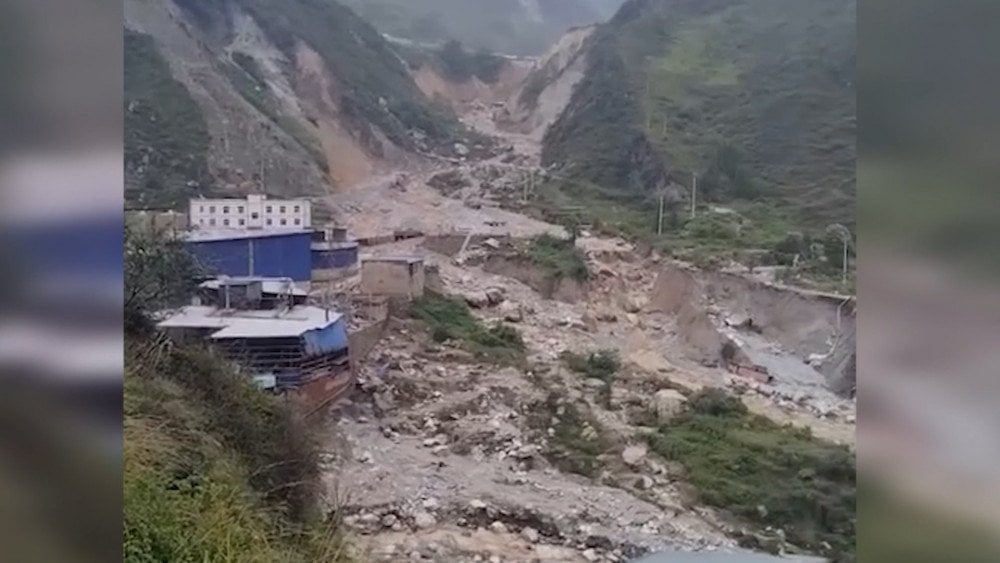
Aftermath of heavy rain in Sichuan Province, China
As of July 21, 10 people died, and 29 were reported missing. Search and rescue operations are still ongoing.
On July 19, a powerful sandstorm painted the sky in the city of Dunhuang, Gansu Province, in a cloudy yellow color.
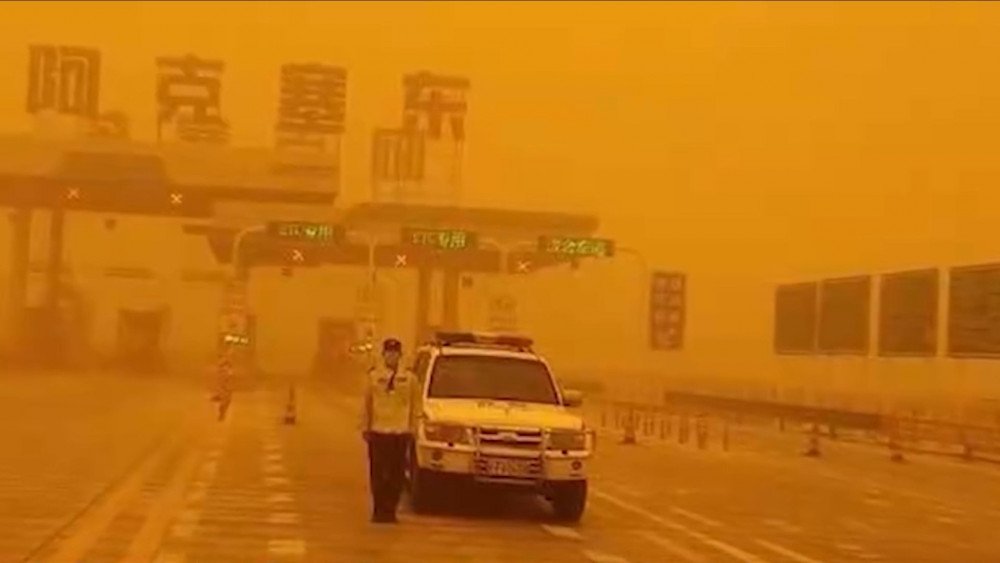
Sandstorm turns the sky cloudy yellow, Gansu Province, China
Strong winds carried sand through the air, reducing visibility to less than 100 meters (328 feet).
Traffic police imposed temporary traffic control on the Liugou Expressway G3011 to ensure safety.
The popular tourist area in the Mingsha Oasis, with its crescent-shaped spring, was temporarily closed.
On July 20, visitors to the Great Wall of China were hit by rain with squally winds that knocked people off their feet.
On the night of July 22, Typhoon Prapiroon hit southern China, bringing heavy rain and strong winds to Hainan Island. In 24 hours, more than 100 mm (3.94”) of rain fell in 12 cities and counties. In Wanning City, Hainan Province, wind gusts exceeded 38 m/s (85 mph).
On the path of the typhoon, in Guangdong and Guangxi provinces, more than 26,000 tourists were evacuated.
Ferry and high-speed train services were suspended on the island, and attractions in the popular tourist city of Sanya were temporarily closed.

High-speed trains suspended due to heavy rains on Hainan Island, China
It is evident that the forecast mentioned at the beginning of the report is already coming true. This is especially evident in China.The country is engulfed in incessant disasters. They are claiming lives and literally destroying the country.
According to the Office of the National Committee for Disaster Prevention and Control of China, in the first half of 2024 alone, 322 people died or went missing due to natural disasters, while 32.381 million people were affected. In the first half of 2024, economic losses from the disasters amounted to $13.042 billion.
Conclusion
China undoubtedly possesses a high level of technical expertise. However, this alone is not enough to cope with the escalating destructive natural disasters. Moreover, the loss of this country’s potential would be catastrophic for humanity as a whole.
And most importantly, these disasters won’t stop at China alone. In the coming years, they will devastate the entire planet.
For several years, our international team of volunteers has been daily monitoring the climate situation on the planet. We are doing this to objectively compile an overall picture of what is happening and convey it to people. The longer society remains blind to this reality, the more likely it is that the negative forecast for the planet and all of humanity will come true.
The most common question in the comments on videos and articles about climate disasters is: what should we do?
First and foremost, it’s essential that as many people as possible understand what is happening to our planet and what awaits us in the future. Informing the public is a key step in addressing this issue. It is for this purpose that weekly monitoring reports are being released, and a series of forums and conferences “Global Crisis” has been organized by scientists together with volunteers.
When society fully grasps the seriousness of the situation, this problem will become a top priority. This will unite the scientific potential of humankind, helping to study the problem more deeply and find a solution.
Since this is our common problem, it must be solved by the entire world.
And when humanity eliminates the climate threat, people will realize how much better, more efficient, safer, and more beautiful it is to unite rather than to conflict and divide. This, in turn, will allow us to build a world where wars cease, and society evolves, taking a leap forward in development.
These are very real prospects, which now depend on your decision.
You can view the video version of this article here.
Leave a comment